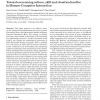Free Online Productivity Tools
i2Speak
i2Symbol
i2OCR
iTex2Img
iWeb2Print
iWeb2Shot
i2Type
iPdf2Split
iPdf2Merge
i2Bopomofo
i2Arabic
i2Style
i2Image
i2PDF
iLatex2Rtf
Sci2ools
113
click to vote
UAIS
2002
2002
Toward overcoming culture, skill and situation hurdles in Human-Computer Interaction
Abstract. This paper proposes a new effective strategy for designing and implementing interactive systems overcoming culture, skill and situation hurdles in HumanComputer Interaction (HCI). The strategy to identify and reduce these hurdles is developed in the framework of a methodology based on a recently introduced model of HCI, and exploits the technological innovations of XML (Extensible Markup Language). HCI is modelled as a cyclic process in which the user and the interactive system communicate by materializing and interpreting a sequence of messages. The interaction process is formalized by specifying both the physical message appearance and the computational aspect of the interaction. This formalization allows the adoption of notation traditionally adopted by users in their workplaces as the starting point of the interactive system design. In this way, the human
| Added | 23 Dec 2010 |
| Updated | 23 Dec 2010 |
| Type | Journal |
| Year | 2002 |
| Where | UAIS |
| Authors | Paola Carrara, Daniela Fogli, Giuseppe Fresta, Piero Mussio |
Comments (0)

